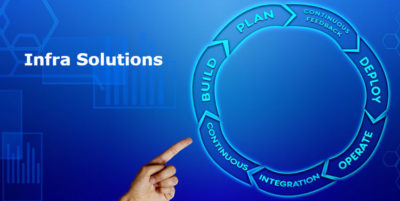Enterprises deal with a pool of data generated from different sources. Each enterprise needs to recognize their need for data storage and the robust solution that can deal with competitive demand. Over 90 percent of the data around the world was generated in the past two years and the speed of data generation is overtaking the development of data storage. It also estimated that the current speed of data generation is close to 2.5 quintillion bytes per day. Most enterprises estimate that the rate of data growth will be almost 10 to 24 percent per year. The increase in information has proliferated the demand for data storage solutions and has made many of the enterprises question the current solutions for data storage and management. Close to 51 percent of the enterprises manage between 1 to 99 terabytes of data; while close to 9 percent of them have 1 petabyte of data storage solutions.
The increased demand for data management and catering to the applications of modern-day business many of the current enterprises are dealing with different storage solutions. Enterprises have also realized that new technological improvements need to be made when managing the current data storage solutions are falling short. The current AI and IoT requirement need data solutions that reduce latency and with improved processing speed. The data storage solutions over the years have differed from going to maximum storage solutions to secured and faster solutions. Different types of cyber threats and blunt security data breaches enterprises also have to deal with network security solutions to deal with the threats.
To Help The Enterprises Evaluate Different Types Of Storage Solutions You Can Read The Following Details About Enterprises.
1. Direct Attached Storage (DAS)
Direct Attached Storage (DAS) comes directly attached to the servers, systems and other devices rather than completely different storage. As the storage solutions are directly attached to the device, it gives the highest bandwidth compared to any other solution. DAS solutions are comparatively cost friendly and offer a systemized solutions, however, if the storage requirements increase the benefits usually disappear. Upgrading the DAS might involve the system-wide completely shutting all the functions. Functions that have limited data storage requirements can benefit from storage solutions and the security benefits are also higher compared to any other storage solutions. HPE Proliant Servers are the rack-optimized software defined servers that offer workload that can be controlled using the single infrastructure management solution.
2. Cloud Storage Solution
The usage of the cloud storage is rising rapidly as the enterprises are relying on the cloud storage to fulfill their storage requirements. Today, every enterprise relies on some form of cloud data storage solutions to deal with storage requirements. Cloud storage solutions offer varied services to enterprises with easy data recovery and disaster data management solutions can help enterprises deal with every type of data. The current benefit of dealing with storage solutions that includes cloud is the flexibility of remote access and cost of the infrastructure. Cloud providers are actually third-party storage providers that deliver the total infrastructure solutions and the enterprises are meant to pay only for the storage rather than for complete infrastructure. Many of the cloud providers also feature pay per usage making it a flexible storage solution than others. The only problem when dealing with cloud storage solutions is networking requirements and the storage speed that will depend on the bandwidth between the storage and transfer speed. Security is also one of the concerns as IT admins need to be on their toes dealing with storage. Security in the cloud needs to policy-driven along with strategical defined for the access.
3. Network Attached Storage (NAS)
Network Attached Storage (NAS) is a mix of traditional benefits from the local drive combined with cloud storage solutions. Using the NAS, the enterprises can access the data at the same file level, offering the data access to the network through the dedicated applications that manage the storage and access. The network connected devices aren’t limited by the simple storage solutions. One of the major disadvantages of using the NAS is that many of devices that are currently being accessing the network depend on the network, slowing down the speed and congestion during the peak hours. During the peak time usage, the network has to be thoroughly tested that it will be able to access the network.
4. Storage Area Network (SAN)
Storage Area Network (SAN) is a specialized high-speed network that provides high-speed block level network access to the storage. SANs are a composition of hosts, switches, storage elements that can be interconnected using different topologies, technologies, and protocols that can be effectively managed using the SAN management solution. SANs provide an overview that the storage device is actually present at the host rather than the storage appears to be just locally attached. Though there is a pool of data storage solutions that can be offered to the enterprises, most of them fail to actually acknowledge the solution. Enterprises believe that various data storage solutions deal with different requirements and already displayed complications can differ in the storage requirements.
Solutions
1. Dell EMC
One of the most foremost data solutions for the enterprises is the Dell EMC. The external storage system market is currently dominated with arrays that can satisfy the requirements for both SAN and NAS. With varied product lines that deal with Isilon NAS storage, EMC unity hybrid flash storage array for block and file storage.
2. HPE
The notable HPE product lines that deal with HPE 3PAR storeserv midrange arrays, entry-level HPE with the storeeasy storage NAS system and the flash-enabled MSA storage.
3. Cloud Solutions
With AWS and Microsoft dominating the solution for cloud requirements, the enterprises have various other options that include Cisco, IBM, Rackspace, and Google.
If Virtual Data environment is the requirements of the enterprises then DAS, NAS, and SAN offer a different course of options. Choose DAS if the requirement is meant to be closely followed by cost and the need is low and requires less-advanced features. Chose the SAN or NAS if your building a large scale virtual environment, NAS is better option dealing with cloning of a large number of virtual hosts. SAN will also offer better resiliency or availability considering the environment.
To know more about the infrastructure solutions, you can download our whitepapers.












